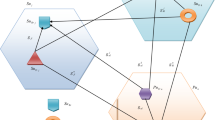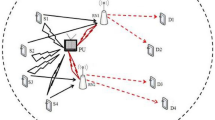Abstract
Cognitive Radio Network (CRN) has been proposed in recent years to solve the spectrum scarcity problem by exploiting the existence of spectrum holes. One of the important issues in the cellular CRNs is how to efficiently allocate primary user (PU) spectrum inside a CRN cell without causing harmful interference to PUs. In this paper, we present a cross-layer framework which jointly considers spectrum allocation and relay selection with the objective of maximizing the minimum traffic demand of secondary users (SUs) in a CRN cell. Specifically, we consider (1) CRN tries to utilize PU spectrum even when the CRN cell is not completely outside the protection region of the PU cell, and (2) cooperative relay is used in cellular CRNs to improve the utilization of PU spectrum. We formulate this cross-layer design problem as a Mixed Integer Linear Programming (MILP) and propose a low complexity heuristic algorithm to solve it. Compared to a simple channel allocation scheme, the numerical results show a significant improvement by using our proposed method and the performance is close to the optimal solution. We further consider the spectrum allocation among several CRN cells with the objective of maximizing the overall minimum throughput of all cells while ensuring each individual cell’s minimum throughput requirement. A low complexity algorithm is proposed to achieve the objective with satisfactory performance.









Similar content being viewed by others
Notes
White space of PU spectrum refers to the PU spectrum which is currently not occupied by PUs, while grey space of PU spectrum, according to [1], is the spectrum that is currently partially occupied by PUs. Specifically in this work, if channel b is grey space, it means some PU BS is currently using channel b. However, CRN BS can sense channel b’s busy state, and opportunistically reuse channel b in some area of the CRN cell as long as its reuse will not cause any harmful interference to PU BS.
Specifically, \(h_{m,n}^{i}=s_{m,n}^{-\eta } \rho_{m,n}^{i}\), where \(s_{m,n}^{-\eta }\) is the path loss of link (m,n) with exponent η (we set η = 4) and \(\rho_{m,n}^{i}\) is a normalized random factor modeling the frequency selective fading across different channels. In this work, we set \(\rho_{m,n}^{i}=1\) for simplicity.
We assume all SUs have the same antenna gain G SU .
Notice that in practical application, these values should be discrete values instead of real values. Therefore, for practical application, we can approximate the real values by the closest discrete values. As long as there are many slots in each frame, the performance using real values will be close to the practical case.
In the previous single CRN cell case, the BS performs the central scheduling. Now for the multiple CRN cells case, we need a central coordinator to schedule among different cells, just like the Mobile Switching Center (MSC) in the traditional cellular networks.
Notice that in this work, we assume that the PU spectrums are slow changing and the PU is not coming back in the middle of a CRN MAC frame. However, in reality, the PU may come back in the middle of a CRN MAC frame. In that case, both the performance of our schemes and the performance of the simple scheme should be slightly decreased. This situation also exists in the following results.
References
Akyildiz IF, Lee WY, Vuran MC, Mohanty S (2006) Next generation/dynamic spectrum access/cognitive radio wireless networks: a survey. Comput Networks (Elsevier) 50(13):2127–2159
Cho J, Haas ZJ (2004) On the throughput enhancement of the downstream channel in cellular radio networks through multihop relaying. IEEE J Sel Areas Commun 22(7):1206–1219
Hou YT, Shi Y, Sherali HD (2008) Spectrum sharing for multi-hop networking with cognitive radios. IEEE J Sel Areas Commun 26(1):146–155
Ma M, Tsang DHK (2009) Joint design of spectrum sharing and routing with channel heterogeneity in cognitive radio networks. Physical Communication 2(1–2):127–137
Wu Y, Tsang DHK (2009) Dynamic rate allocation, routing and spectrum sharing for multi-hop cognitive radio networks. In: Proc. of IEEE international conference on communications workshops, 14–18 June 2009, pp 1–6
Katzela I, Naghshineh M (1996) Channel assignment schemes for cellular mobile telecommunication systems: a comprehensive survey. IEEE Pers Commun 3(3):10–31
Liu Y, Hoshyar R, Yang X, Tafazolli R (2006) Integrated radio resource allocation for multihop cellular networks with fixed relay stations. IEEE J Sel Areas Commun 24(11):2137–2146
Jia J, Zhang J, Zhang Q (2009) Cooperative relay for cognitive radio networks. In: Proc. IEEE INFOCOM 2009, pp 2304–2312
Zhang Q, Jia J, Zhang J (2009) Cooperative relay to improve diversity in cognitive radio networks. IEEE Commun Mag 47(2):111–117
IEEE 802.22 WG (2007) Draft standard for wireless regional area networks part 22: cognitive wireless RAN medium access control (MAC) and physical layer (PHY) specifications: policies and procedures for operation in the TV bands. IEEE P802.22/D0.3.8.1
Cordeiro C, Challapali K, Birru D (2006) IEEE 802.22: an introduction to the first wireless standard based on cognitive radios. IEEE J Commun 1(1):38–47
Lee WY, Akyildiz IF (2008) Joint spectrum and power allocation for inter-cell spectrum sharing in cognitive radio networks. In: Proc. IEEE DySPAN 2008, pp 1–12
Lingo User’s Guide (2006) Lindo Systems Inc., Chicago, Illinois, USA, pp 637
Author information
Authors and Affiliations
Corresponding author
Additional information
The short version of this paper was presented in WICON 2010.
Rights and permissions
About this article
Cite this article
Zhang, T., Wu, Y., Lang, K. et al. Joint Spectrum Allocation and Relay Selection in Cellular Cognitive Radio Networks. Mobile Netw Appl 16, 748–759 (2011). https://doi.org/10.1007/s11036-010-0264-4
Published:
Issue Date:
DOI: https://doi.org/10.1007/s11036-010-0264-4




